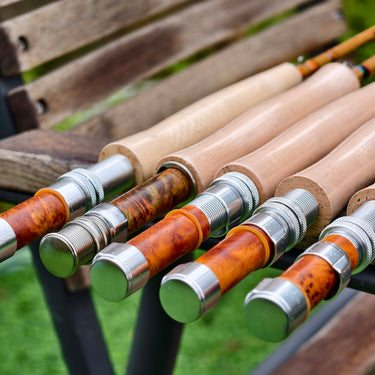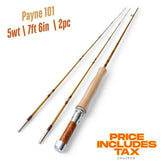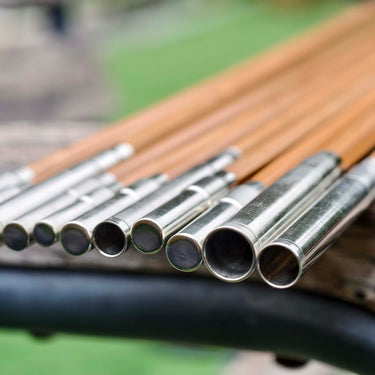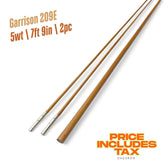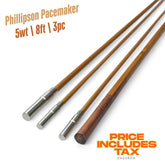The Art and Science of Bamboo Fly Rod Making: A Comprehensive Technical Guide

Bamboo fly rods occupy a unique place in angling history, embodying a perfect marriage between natural material properties and human craftsmanship. For centuries, these exquisite tools have served fishermen across cultures, from the Japanese wazao masters to the legendary American rod makers like E.W. Garrison. This guide systematically explores the two core processes in bamboo rod construction—material selection and planing techniques—blending Eastern traditional methods with Western engineering principles to provide rod-making enthusiasts with a complete professional reference.
Scientific Bamboo Selection: From Species Identification to Pre-treatment
The foundation of a superior bamboo rod begins with material selection, a process far more nuanced than simply choosing straight culms. It demands a systematic understanding of bamboo species characteristics, growth patterns, and physical properties. In Asian rod-making traditions, species like yadake (矢竹), madake (真竹), koyachiku (高野竹), and Sichuan arrow bamboo each possess distinct qualities
. Yadake boasts exceptional fiber density and rebound elasticity, making it ideal for rods requiring quick response. Madake, with its widespread availability and uniform node spacing, serves as an excellent choice for beginners. Internationally, Tonkin bamboo (Arundinaria amabilis) from China's Guangdong province is revered by masters like Garrison and Cattanach as the premier rod-making material, especially for fly rods enduring substantial stress, due to its tight fibers, thick walls, and exceptional longitudinal strength.
Determining bamboo age constitutes a critical selection parameter. Culms younger than three years contain excessive moisture and underdeveloped lignin, resulting in rods prone to warping and cracking. Conversely, bamboo older than five years suffers from cellulose degradation that diminishes toughness. The optimal harvest age is 3-5 years, when bamboo achieves the perfect balance between strength and flexibility
. Seasonal timing proves equally crucial—winter harvests (November-February) yield bamboo with lower starch content, significantly reducing risks of insect damage and mold while producing denser fiber structures. In southern China's Sichuan and Yunnan provinces, craftsmen specifically select bamboo grown on sunny slopes above 800m elevation. These plants, having competed for sunlight at high altitudes, develop fewer branches, straighter trunks, and stronger mechanical tissues adapted to mountainous winds.
Proper pre-treatment establishes the foundation for subsequent processing quality. Freshly cut bamboo should first undergo 1 year of air-drying followed by 1 year of sun-drying, stabilizing moisture content between 12-15%
. Air-drying must avoid direct sunlight, ideally occurring in well-ventilated shelters maintaining 50-60% relative humidity to prevent cracking. Industrial production may employ drying kilns to accelerate this process, but temperatures must remain below 50°C to avoid damaging the bamboo's natural resins. In Fujian's Nanping workshops, artisans utilize a smoking technique where rice husk combustion creates weakly acidic smoke that repels insects while promoting protective oxidation layers on bamboo surfaces.
Material screening requires evaluating both macroscopic and microscopic characteristics: internode spacing should be uniform (≤10% variation), overall straightness deviation under 0.5%, and wall thickness variation within 15%. Cross-sectional inspection reveals quality bamboo displays evenly distributed vascular bundles resembling sesame seeds, with densities reaching 25-30 per square millimeter. Nodes must be smooth without protrusions, and nodal membranes intact. The tap test—where clear, lingering tones indicate uniform, dense fiber structures—often proves that only one or two in ten culms meet these stringent criteria, underscoring the scarcity value of premium bamboo rods
.
Traditional Planing Tools and Hexagonal Splice Principles

Bamboo rod planing represents a technology blending precision mechanics and artistic intuition, where tool system design directly determines blank performance and aesthetics. The classic hexagonal splice technique in Western fly rod making demands six bamboo strips match precisely, imposing extreme demands on planing tools. Garrison's seminal writings detail his specialized planing bench construction: a cast iron base ensures stability, with guide rails flat within 0.02mm tolerance. The adjustable tool holder achieves 1/4-degree precision, paired with specialized double-edged planing blades ground to 25 degrees for efficient cutting without fiber tearing
. Cattanach advocated a more economical homemade solution using hardwood planing tables with replaceable steel guides, costing merely 1/5 of professional equipment yet achieving comparable accuracy through meticulous calibration.
Eastern traditional tools, while differing in form, maintain equally rigorous accuracy standards. The gyokku-giri (玉口刀) knife for trimming node connections requires HRC60+ hardness, with bamboo-contact surfaces hand-polished to mirror finishes minimizing friction. Node reamers employ a 0.2mm incremental system, starting from 3mm with twenty sequentially sized tools—skipping steps risks uneven wall thickness or bursting. Straightening boards typically use oil-treated beech or sandalwood, developing non-stick surfaces that work with infrared heaters for millimeter-scale adjustments
.
The hexagonal splice's scientific rationale lies in optimized stress distribution. When six bamboo strips bond under heat to form a hexagonal cross-section, its moment of inertia becomes 36 times greater than a single strip's, indicating exponential stiffness enhancement. Garrison's experiments demonstrated hexagonal sections create uniform stress rings under load, preventing localized stress concentrations causing fractures
. His seminal taper equation classified rod actions into parabolic and progressive types by varying strip planing slopes to precisely control bending characteristics. For instance, his model 209E employs a 1:80 taper in the butt section for powerful support, transitioning to 1:120 tip for sensitive response.
Pre-planing preparations remain equally critical. Strips require straightening through localized heating to approximately 150°C (when bamboo oil emerges), then adjusted on straightening boards—a process repeated 10-20 times until达标. Insufficient heating allows rebound, while overheating causes carbonization and brittleness
.
Taper Design and Stress Distribution Physics
Rod taper design constitutes the most scientifically profound aspect of construction, directly determining a rod's "soul"—its action characteristics. Garrison distilled his lifelong research into a mathematical modeling system converting rod bending curves under load into specific strip dimensions through differential equations. In A Master's Guide to Building a Bamboo Fly Rod, he derived the relationship between bending moment M(x) and cross-sectional moment of inertia I(x): M(x)=E·I(x)·κ(x), where E represents bamboo's elastic modulus and κ(x) curvature radius. By defining ideal κ(x) distributions, the formula back-calculates required I(x) values at each position, ultimately translating to individual strip thicknesses along their lengths
. This materials science-based approach elevated rod making from empirical craft to precision engineering.
Parabolic and progressive actions represent two fundamental behavior patterns. Parabolic rods (e.g., Garrison 212) feature smooth continuous bending from butt to tip, ideal for long-distance stream casting. This design maintains small taper change rates (dt/dx) in butt sections, ensuring wave-like energy transmission. Progressive rods (e.g., 209E) exhibit distinct bending transitions—under normal loads primarily flexing the front third, only engaging the rear when fighting larger fish. This suits precise short-range fishing. Modern composite rods' "fast action" concept was essentially achieved by Garrison through bamboo taper designs as early as the 1940s
.
Practical taper measurement requires specialized tools and methods. Traditional workshops use micrometers for manual measurements, recording thickness at 10-15 axial positions per strip, with corresponding points on six strips varying less than 0.02mm. Cattanach developed a sliding gauge with laser alignment, allowing real-time monitoring of dimensional deviations from design values during planing
.
Bamboo's natural properties introduce unique advantages and challenges for taper design. Unlike homogeneous materials like carbon fiber, bamboo's fiber gradient distribution gives outer walls (bamboo skin) tensile strength reaching 300MPa, far exceeding inner walls' (bamboo pulp) 80MPa. Skilled makers intentionally preserve more outer-layer fibers in high-stress areas. Holden's The Idyll of the Split-Bamboo documents traditional "fiber alignment" artistry—six strips' fiber patterns must mirror each other like book-matched pages, enabling coordinated deformation under load
. Modern microscopy confirms this arrangement increases interfacial shear strength by 40%.
Planing Process: Operational Steps and Quality Control
Translating designs into physical rods through planing becomes a test of precision and patience. Preparation begins with rough processing—selecting raw bamboo with walls ≥5mm thick, then splitting radially into six equal segments using a specialized cleaver. This splitting must follow fiber orientation perfectly; any transverse tearing renders the strip unusable. Experienced craftsmen judge quality by splitting sounds: crisp "cracks" indicate healthy bamboo, while dull "tears" suggest hidden defects
.
Planing follows strict sequential protocols. Rough strips mount on planing benches where initial blades remove inner pulp layers to ~3.5mm thickness, primarily relieving internal stresses. Precision blades then incrementally adjust cutting depths according to taper designs, requiring measurements every 10cm. Garrison emphasized "three-face balancing"—each pass should treat both strip edges before the center, preventing stress-imbalance-induced warping. For abrupt taper transitions (e.g., tip areas), cutting depths reduce to 0.1mm/pass with increased inspection frequency
.
Final pre-glue preparations determine overall strength. Temporarily assembled strips undergo light-gap inspection under natural light—no visible transmission indicates perfect fits. Joint surfaces receive 800-grit sanding to increase glue adhesion, but ≤0.05mm depth to avoid damaging load-bearing fibers. Traditional shellac requires 120°C/20min activation, while modern epoxies recommend vacuum degassing. Glue pressure optimally maintains 0.3-0.5MPa—excessive pressure squeezes out adhesive causing weak joints, while insufficient pressure creates voids
.
Daily Maintenance of Bamboo Fly Rods
A proper maintenance regimen significantly extends rod longevity. After each use, wipe blanks with a slightly damp cloth, especially cleaning salt deposits around guide feet. Seasonal maintenance involves citrus oil cleaning followed by beeswax polishing. Before long-term storage, apply specialized inner-wall oils (e.g., Japan's Fujiyama rod oil), storing at 15-25°C and 50-60% humidity, with monthly inspections
. Bamboo rods following these practices can last over 50 years, developing unique amber patinas that transform them into inheritable artworks.
From selecting the perfect culm to completing a high-performance fishing instrument, this manufacturing system blending natural science and human artistry produces not merely superior fishing tools, but preserves ancient wisdom about humanity's dialogue with nature. In today's industrialized world, every scratch on a handmade bamboo rod materializes the maker's philosophy, awaiting anglers who can decipher its embedded material language.
: Carbon fiber rod manufacturing process and bamboo material preparation techniques: Simplified bamboo rod making steps focusing on material selection and straightening methods: Traditional bamboo utensil production techniques including harvesting timing and pretreatment: Bamboo fly rod characteristics, maintenance advice, and historical context: Historical evolution of antique bamboo rods and construction techniques from different periods








